丝印工艺流程样单
- 格式:xls
- 大小:22.50 KB
- 文档页数:1
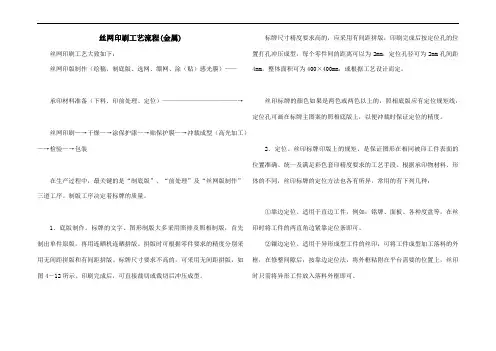
丝网印刷工艺流程(金属)丝网印刷工艺大致如下:丝网印版制作(绘稿、制底版、选网、绷网、涂(贴)感光膜)——承印材料准备(下料、印前处理、定位)————————————→丝网印刷—→干燥—→涂保护漆—→贴保护膜—→冲裁成型(高光加工)—→检验—→包装在生产过程中,最关键的是“制底版”、“前处理”及“丝网版制作”三道工序。
制版工序决定着标牌的质量。
1.底版制作。
标牌的文字、图形制版大多采用照排及照相制版,首先制出单件原版,再用连晒机连晒拼版。
拼版时可根据零件要求的精度分别采用无间距拼版和有间距拼版。
标牌尺寸要求不高的,可采用无间距拼版,如图4-12所示。
印刷完成后,可直接裁切或裁切后冲压成型。
标牌尺寸精度要求高的,应采用有间距拼版,印刷完成后按定位孔的位置打孔冲压成型,每个零件间的距离可以为2mm,定位孔径可为2mm孔间距4mm,整体面积可为400×400mm,或根据工艺设计而定。
丝印标牌的颜色如果是两色或两色以上的,照相底版应有定位规矩线,定位孔可画在标牌主图案的照相底版上,以便冲裁时保证定位的精度。
2.定位。
丝印标牌印版上的规矩,是保证图形在相同被印工件表面的位置准确、统一及满足彩色套印精度要求的工艺手段。
根据承印物材料、形体的不同,丝印标牌的定位方法也各有所异,常用的有下列几种:①靠边定位。
适用于直边工件,例如:铭牌、面板、各种度盘等,在丝印时将工件的两直角边紧靠定位条即可。
②镶边定位。
适用于异形成型工件的丝印,可将工件成型加工落料的外框,在修整间隙后,按靠边定位法,将外框粘附在平台需要的位置上,丝印时只需将异形工件放入落料外框即可。
③孔定位。
孔定位适用于相同图形的拼版丝印,即先在板材上冲出定位孔,丝印时以孔定位,最后仍以定位孔对工件进行模具落料成型。
④重合定位。
适合在透明材料上丝印套色图形。
定位时可将第二色图案丝印在纸板上,并用印有第一色图案的薄膜覆盖,使两色图案的相同位包符合设计的尺寸要求,然后将印有第一色图的薄膜与平台粘牢,在丝印第二色图案时只需将印有第一色图案的透明工件与平台上的第一色图案重合,即可达到定位的目的。
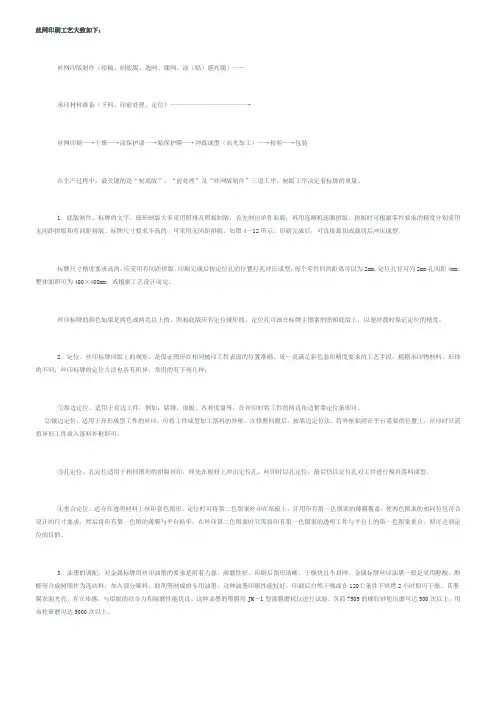
丝网印刷工艺大致如下:丝网印版制作(绘稿、制底版、选网、绷网、涂(贴)感光膜)——承印材料准备(下料、印前处理、定位)————————————→丝网印刷—→干燥—→涂保护漆—→贴保护膜—→冲裁成型(高光加工)—→检验—→包装在生产过程中,最关键的是“制底版”、“前处理”及“丝网版制作”三道工序。
制版工序决定着标牌的质量。
1.底版制作。
标牌的文字、图形制版大多采用照排及照相制版,首先制出单件原版,再用连晒机连晒拼版。
拼版时可根据零件要求的精度分别采用无间距拼版和有间距拼版。
标牌尺寸要求不高的,可采用无间距拼版,如图4-12所示。
印刷完成后,可直接裁切或裁切后冲压成型。
标牌尺寸精度要求高的,应采用有间距拼版,印刷完成后按定位孔的位置打孔冲压成型,每个零件间的距离可以为2mm,定位孔径可为2mm孔间距4mm,整体面积可为400×400mm,或根据工艺设计而定。
丝印标牌的颜色如果是两色或两色以上的,照相底版应有定位规矩线,定位孔可画在标牌主图案的照相底版上,以便冲裁时保证定位的精度。
2.定位。
丝印标牌印版上的规矩,是保证图形在相同被印工件表面的位置准确、统一及满足彩色套印精度要求的工艺手段。
根据承印物材料、形体的不同,丝印标牌的定位方法也各有所异,常用的有下列几种:①靠边定位。
适用于直边工件,例如:铭牌、面板、各种度盘等,在丝印时将工件的两直角边紧靠定位条即可。
②镶边定位。
适用于异形成型工件的丝印,可将工件成型加工落料的外框,在修整间隙后,按靠边定位法,将外框粘附在平台需要的位置上,丝印时只需将异形工件放入落料外框即可。
③孔定位。
孔定位适用于相同图形的拼版丝印,即先在板材上冲出定位孔,丝印时以孔定位,最后仍以定位孔对工件进行模具落料成型。
④重合定位。
适合在透明材料上丝印套色图形。
定位时可将第二色图案丝印在纸板上,并用印有第一色图案的薄膜覆盖,使两色图案的相同位包符合设计的尺寸要求,然后将印有第一色图的薄膜与平台粘牢,在丝印第二色图案时只需将印有第一色图案的透明工件与平台上的第一色图案重合,即可达到定位的目的。
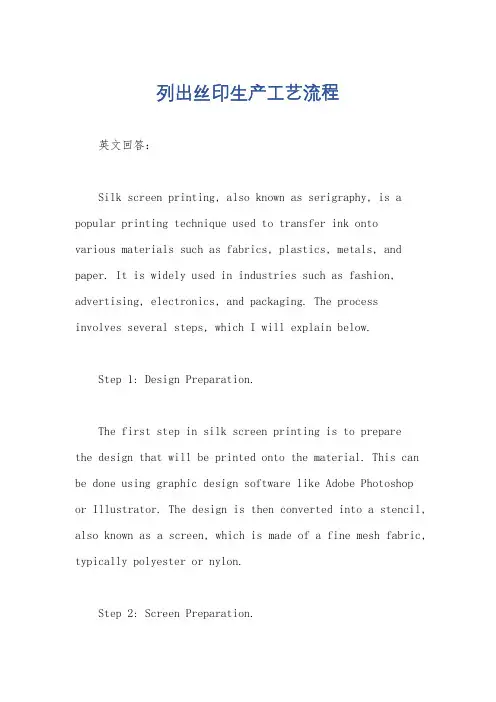
列出丝印生产工艺流程英文回答:Silk screen printing, also known as serigraphy, is a popular printing technique used to transfer ink ontovarious materials such as fabrics, plastics, metals, and paper. It is widely used in industries such as fashion, advertising, electronics, and packaging. The processinvolves several steps, which I will explain below.Step 1: Design Preparation.The first step in silk screen printing is to preparethe design that will be printed onto the material. This can be done using graphic design software like Adobe Photoshopor Illustrator. The design is then converted into a stencil, also known as a screen, which is made of a fine mesh fabric, typically polyester or nylon.Step 2: Screen Preparation.Once the design is ready, the screen needs to be prepared. The mesh fabric is stretched tightly over a frame, usually made of aluminum or wood. The screen is then coated with a light-sensitive emulsion or photo-reactive chemical. This emulsion is sensitive to ultraviolet (UV) light.Step 3: Exposure.In this step, the prepared screen is placed in a vacuum frame or exposure unit. The design stencil is placed on top of the screen, and both are exposed to UV light. The UVlight hardens the emulsion in the areas not covered by the design, creating a stencil with open areas where the inkwill pass through.Step 4: Washout.After exposure, the screen is washed with water or a special emulsion remover to remove the unhardened emulsion. This leaves behind the stencil with the desired design. The screen is then dried before moving on to the next step.Step 5: Printing.Now comes the actual printing process. The screen is mounted onto a printing press or a manual frame. The material to be printed is placed underneath the screen, and ink is poured onto the top of the screen. A squeegee is then used to spread the ink evenly over the stencil,forcing the ink through the open areas and onto the material below. The squeegee is moved across the screen in a smooth, sweeping motion, ensuring complete coverage of the design.Step 6: Curing.Once the printing is complete, the printed material needs to be cured to ensure that the ink adheres properly. This is typically done by heat curing, where the materialis passed through a conveyor dryer or a heat press. The heat cures the ink, making it durable and resistant to fading or washing.Step 7: Finishing.After curing, the printed material is inspected for quality control. Any defects or imperfections are corrected, and the finished product is packaged and prepared for delivery.中文回答:丝印生产工艺流程,又称丝网印刷,是一种常用的印刷技术,用于将油墨转移到各种材料上,如织物、塑料、金属和纸张。
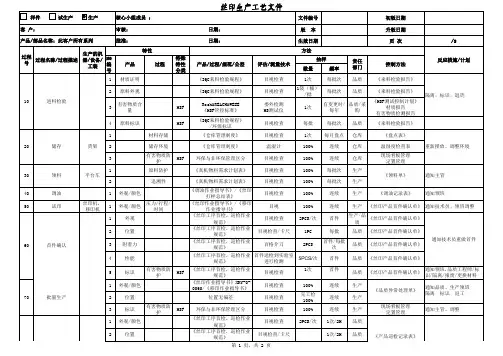
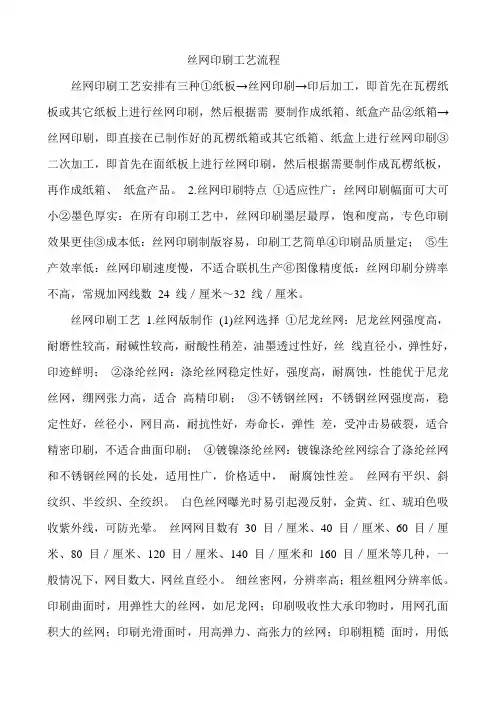
丝网印刷工艺流程丝网印刷工艺安排有三种①纸板→丝网印刷→印后加工,即首先在瓦楞纸板或其它纸板上进行丝网印刷,然后根据需要制作成纸箱、纸盒产品②纸箱→丝网印刷,即直接在已制作好的瓦楞纸箱或其它纸箱、纸盒上进行丝网印刷③二次加工,即首先在面纸板上进行丝网印刷,然后根据需要制作成瓦楞纸板,再作成纸箱、纸盒产品。
2.丝网印刷特点①适应性广:丝网印刷幅面可大可小②墨色厚实:在所有印刷工艺中,丝网印刷墨层最厚,饱和度高,专色印刷效果更佳③成本低:丝网印刷制版容易,印刷工艺简单④印刷品质量定;⑤生产效率低:丝网印刷速度慢,不适合联机生产⑥图像精度低:丝网印刷分辨率不高,常规加网线数24 线/厘米~32 线/厘米。
丝网印刷工艺1.丝网版制作(1)丝网选择①尼龙丝网:尼龙丝网强度高,耐磨性较高,耐碱性较高,耐酸性稍差,油墨透过性好,丝线直径小,弹性好,印迹鲜明;②涤纶丝网:涤纶丝网稳定性好,强度高,耐腐蚀,性能优于尼龙丝网,绷网张力高,适合高精印刷;③不锈钢丝网:不锈钢丝网强度高,稳定性好,丝径小,网目高,耐抗性好,寿命长,弹性差,受冲击易破裂,适合精密印刷,不适合曲面印刷;④镀镍涤纶丝网:镀镍涤纶丝网综合了涤纶丝网和不锈钢丝网的长处,适用性广,价格适中,耐腐蚀性差。
丝网有平织、斜纹织、半绞织、全绞织。
白色丝网曝光时易引起漫反射,金黄、红、琥珀色吸收紫外线,可防光晕。
丝网网目数有30 目/厘米、40 目/厘米、60 目/厘米、80 目/厘米、120 目/厘米、140 目/厘米和160 目/厘米等几种,一般情况下,网目数大,网丝直经小。
细丝密网,分辨率高;粗丝粗网分辨率低。
印刷曲面时,用弹性大的丝网,如尼龙网;印刷吸收性大承印物时,用网孔面积大的丝网;印刷光滑面时,用高弹力、高张力的丝网;印刷粗糙面时,用低网目的丝网;印刷精度高的印刷品时,用低延伸率、高张力的丝网;印刷招牌、纺织品、针织品时,用28 目/厘米~78 目/厘米丝网;印刷纸、金属、玻璃、皮革、塑料时,用40 目/厘米~140 目/厘米丝网。
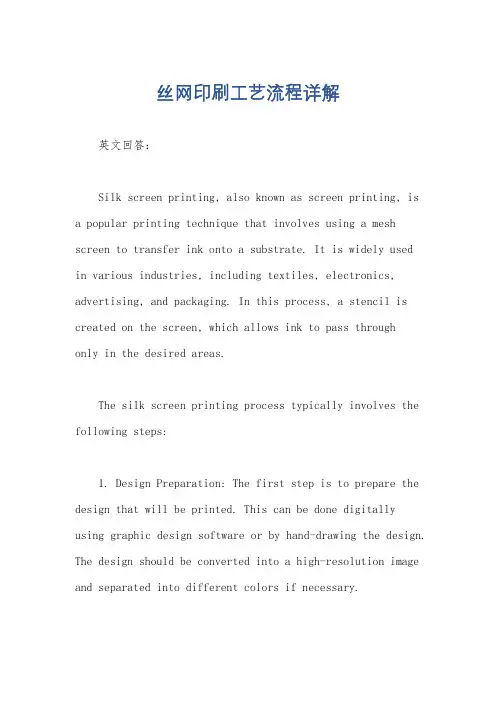
丝网印刷工艺流程详解英文回答:Silk screen printing, also known as screen printing, is a popular printing technique that involves using a mesh screen to transfer ink onto a substrate. It is widely usedin various industries, including textiles, electronics, advertising, and packaging. In this process, a stencil is created on the screen, which allows ink to pass throughonly in the desired areas.The silk screen printing process typically involves the following steps:1. Design Preparation: The first step is to prepare the design that will be printed. This can be done digitally using graphic design software or by hand-drawing the design. The design should be converted into a high-resolution image and separated into different colors if necessary.2. Screen Preparation: A mesh screen is prepared by stretching a fine fabric, such as silk or polyester, over a frame. The screen is then coated with a light-sensitive emulsion or film, which is then dried and exposed to ultraviolet light. The areas that are exposed to light harden, while the unexposed areas remain soft and can be washed away.3. Stencil Creation: After the screen is prepared, a stencil is created by blocking out the areas where ink should not pass through. This can be done using various methods, such as using a stencil film, applying a blocking agent, or using a photo emulsion technique.4. Ink Preparation: The ink used in screen printing is typically a thick, paste-like substance that is mixed with various additives to achieve the desired color, texture, and opacity. The ink is then loaded onto a squeegee, which is used to push the ink through the screen and onto the substrate.5. Printing: The screen is placed on top of thesubstrate, and ink is applied to the screen. The squeegeeis then used to evenly distribute the ink across the screen, forcing it through the open areas of the stencil and onto the substrate. This process is repeated for each color in the design, with each color requiring a separate screen and stencil.6. Drying and Curing: After the printing is complete, the substrate is typically dried or cured to ensure thatthe ink adheres properly. This can be done using heat, air drying, or UV curing, depending on the type of ink and substrate being used.7. Finishing: Once the ink is dry, the printedsubstrate may undergo additional finishing processes, such as trimming, folding, or heat pressing, depending on the desired final product.中文回答:丝网印刷,也被称为丝印,是一种常用的印刷技术,它使用网孔屏幕将油墨转移到基材上。
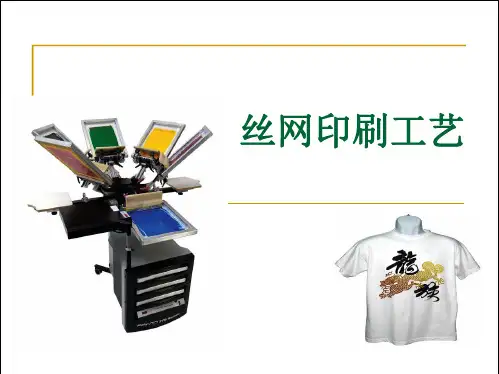
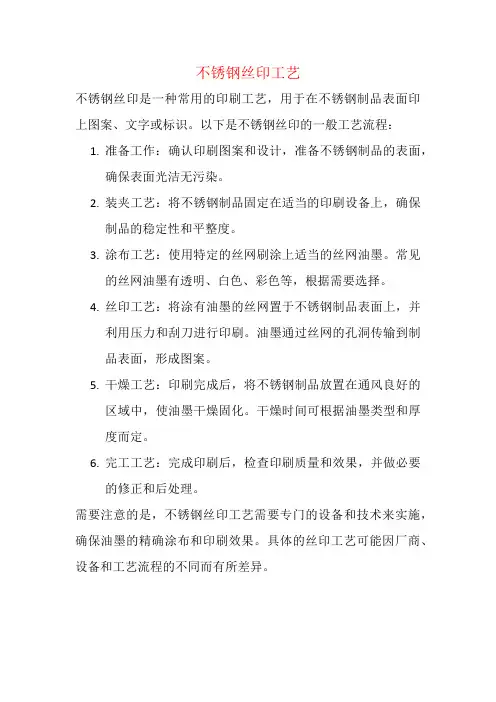
不锈钢丝印工艺
不锈钢丝印是一种常用的印刷工艺,用于在不锈钢制品表面印上图案、文字或标识。
以下是不锈钢丝印的一般工艺流程:
1.准备工作:确认印刷图案和设计,准备不锈钢制品的表面,
确保表面光洁无污染。
2.装夹工艺:将不锈钢制品固定在适当的印刷设备上,确保
制品的稳定性和平整度。
3.涂布工艺:使用特定的丝网刷涂上适当的丝网油墨。
常见
的丝网油墨有透明、白色、彩色等,根据需要选择。
4.丝印工艺:将涂有油墨的丝网置于不锈钢制品表面上,并
利用压力和刮刀进行印刷。
油墨通过丝网的孔洞传输到制
品表面,形成图案。
5.干燥工艺:印刷完成后,将不锈钢制品放置在通风良好的
区域中,使油墨干燥固化。
干燥时间可根据油墨类型和厚
度而定。
6.完工工艺:完成印刷后,检查印刷质量和效果,并做必要
的修正和后处理。
需要注意的是,不锈钢丝印工艺需要专门的设备和技术来实施,确保油墨的精确涂布和印刷效果。
具体的丝印工艺可能因厂商、设备和工艺流程的不同而有所差异。
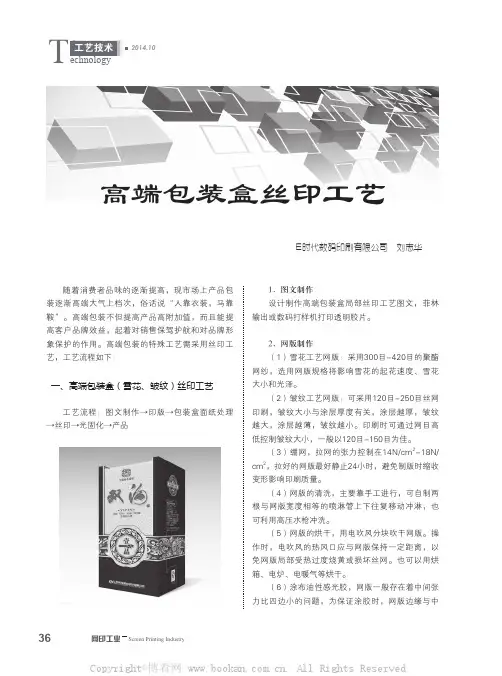
36网印工业 echnologyScreen Printing Industry2014.10工艺技术T高端包装盒丝印工艺E时代数码印刷有限公司 刘志华随着消费者品味的逐渐提高,现市场上产品包装逐渐高端大气上档次,俗话说“人靠衣装,马靠鞍”。
高端包装不但提高产品高附加值,而且能提高客户品牌效益,起着对销售保驾护航和对品牌形象保护的作用。
高端包装的特殊工艺需采用丝印工艺,工艺流程如下:一、高端包装盒(雪花、皱纹)丝印工艺工艺流程:图文制作→印版→包装盒面纸处理→丝印→光固化→产品1.图文制作设计制作高端包装盒局部丝印工艺图文,菲林输出或数码打样机打印透明胶片。
2.网版制作(1)雪花工艺网版:采用300目-420目的聚酯网纱,选用网版规格将影响雪花的起花速度、雪花大小和光泽。
(2)皱纹工艺网版:可采用120目-250目丝网印刷,皱纹大小与涂层厚度有关,涂层越厚,皱纹越大,涂层越薄,皱纹越小。
印刷时可通过网目高低控制皱纹大小,一般以120目-150目为佳。
(3)绷网,拉网的张力控制在14N/cm 2-18N/cm 2,拉好的网版最好静止24小时,避免制版时缩收变形影响印刷质量。
(4)网版的清洗,主要靠手工进行,可自制两根与网版宽度相等的喷淋管上下往复移动冲淋,也可利用高压水枪冲洗。
(5)网版的烘干,用电吹风分块吹干网版。
操作时,电吹风的热风口应与网版保持一定距离,以免网版局部受热过度烧黄或损坏丝网。
也可以用烘箱、电炉、电暖气等烘干。
(6)涂布油性感光胶,网版一般存在着中间张力比四边小的问题,为保证涂胶时,网版边缘与中37网印工业echnologyScreen Printing Industry 2014.10工艺技术T心的胶层均匀一致,可将上胶器的刃口制成略呈凸弧形。
已涂布感光胶烘干后的网版,要避免阳光直射。
(7)曝光,网版的整体画面根据设备大小曝光,要注意将感光的部分和不感光的地方,都用黑纸(布)遮盖好。
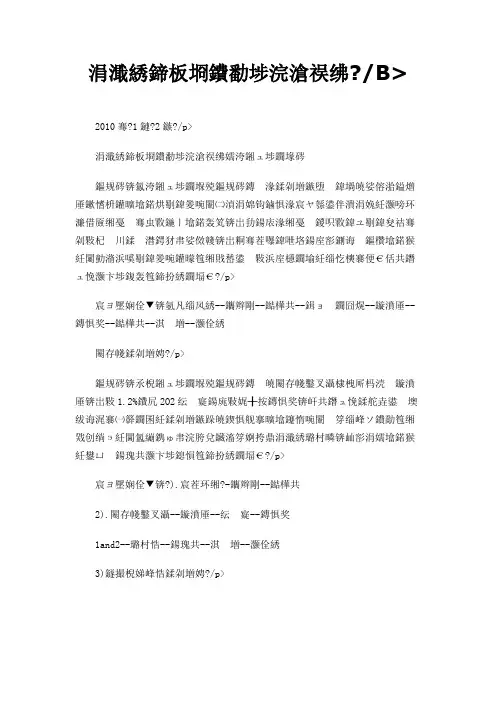
丝网印刷的制作流程2010年11月12日丝网印刷的制作流程直接制版法方法:直接制版的方法是在制版时首先将涂有感光材料腕片基感光膜面朝上平放在工作台面上,将绷好腕网框平放在片基上,然后在网框内放入感光浆并用软质刮板加压涂布,经干燥充分后揭去塑料片基,附着了感光膜腕丝网即可用于晒版,经显影、干燥后就制出丝印网版。
工艺流程:已绷网--脱脂--烘干--剥离片基--曝光--显影--烘干--修版--封网间接制版法方法:间接制版的方法是将间接菲林首先进行曝光,用1.2%的H2O2硬化后用温水显影,干燥后制成可剥离图形底片,制版时将图形底片胶膜面与绷好的丝网贴紧,通过挤压使胶膜与湿润丝网贴实,揭下片基,用风吹干就制成丝印网版。
工艺流程:1).已绷网--脱脂--烘干2).间接菲林--曝光--硬化--显影1and2--贴合--吹干--修版--封网3)直间混合制版法先把感光胶层用水、醇或感光胶粘贴在丝网网框上,经热风干燥后,揭去感光胶片的片基,然后晒版,显影处理后即制成丝网版。
起源发明丝网印刷最早起源于中国,距今已有两千多年的历史了。
早在我国古代的秦汉时期就出现了夹颉印花方法。
到东汉时期夹颉蜡染方法已经普遍流行,而且印制产品的水平也有提高。
至隋代大业年间,人们开始用绷有绢网的框子进行印花,使夹颉印花工艺发展为丝网印花。
据史书记载,唐朝时宫廷里穿着的精美服饰就有用这种方法印制的。
到了宋代丝网印刷又有了发展,并改进了原来使用的油性涂料,开始在染料里加入淀粉类的胶粉,使其成为浆料进行丝网印刷,使丝网印刷产品的色彩更加绚丽。
丝网印刷术是中国的一大发明。
美国《丝网印刷》杂志对中国丝网印刷技术有过这样的评述:"有证据证明中国人在两千年以前就使用马鬃和模板。
明朝初期的服装证明了他们的竞争精神和加工技术?quot;丝网印刷术的发明,促进了世界人类物质文明的发展。
在两千年后的今天,丝网印刷技术不断发展完善,现已成为人类生活中不可缺少的一部分。
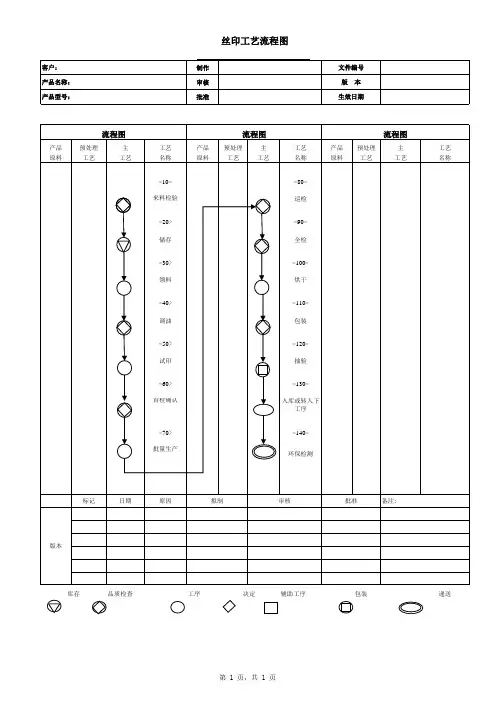
一.移印生产的概念移印----就是利用“显像”的原理,将要印刷的图案先蚀刻在钢板上,然后在移印机上利用软的胶垫(硅橡胶头)把油墨转移印刷在对象上.**移印能够使用于多种工件、形状、位置的印刷,且调整印刷位置极为方便,而且所印装饰图案的效果比喷油、丝印、烫印更显精致美观.***移印机是移印生产的核心,它是利用压缩空气作为原始动力,用电信号控制胶头运动和移印动作(如印刷次数)程序来印刷单色或套印双色至多色图案,可进行1~3次滚动印刷,1~2色转盘印刷及2~6色推盘印刷.(注:移印大图案面积需分段印,但需留意印搭错位问题.)二.移印操作基本原理1.打开气阀→开电闸→按下刮刀动作按钮→再按下起动按钮→按下自动循环印刷按钮→移印机开始工作.2.根据移印图案的要求,调节前后动作气掣及刮刀起落气掣,如是多色印刷,可通过功能读数调节所需要移印的循环次数.3.根据环境气候、油墨、开油水、钢板图案深浅、气压大小(通常3~5BAR)等来调节移印胶头的前后运动,延时数据.三.移印生产工艺流程图(四.移印机各部分说明1.移印机主机**选择合适的移印机----要考虑印刷对象的面积及体积大小选定移印机,根据需要选择“单色”、“双色”或“滚动式”印刷等功能,而依照机器《操作说明书》来选择及使用表盘、按键,确定相应功能及设定工艺参数.2.移印铜板●网板的尺寸是以印刷图案的面积来衡量,通常钢板面积不需太大,否则很难固定钢板在油盘上的位置,而不同尺寸的钢板要配合尺寸相符的油墨盘、刀夹和油扫.●移印钢板的安装调试:首先装好钢板,必须紧贴油盘底面,固定好钢板,令其不可前后左右移动;然后按动前置气动掣,停稳后装好油扫,装好刮刀,然后调整刮刀使其刀口与钢皮面平行.3.移印胶头○1有关要求●一般将移印胶头分为三种硬度:软(30°A),适中(35°A),硬(40°A),较精细的图案宜选用较硬的移印胶,而若印件表面凸凹不平,最好先用较为软性的移印胶以减少损耗.●移印胶头的形状根据移印件有高低不平而选择修整,这一点很重要,由于移印胶头要把平面钢板之蚀刻图案部位的油墨带到凸凹不平的印件上,故移印胶头必须修整为适合印件的弧位、转角及凸凹位.○2胶头制造●胶头由三种材料制成:a,橡胶浆 b.,硅油c,催干剂●将三种材料混和后的胶浆倒入选定形状胶头的吸塑罩模或镀铜模中(之前模需用机油或WD40清洁),更在胶面上附粘上一小块木块,用来在机上紧固定位),之后大约12小时便可固化.●移印胶头的软硬度:硅(硅)油成份加入越多则胶头越软,反之硅油量加入少则胶头硬,催干剂加入量的多少只是调整胶头成形的快慢,对胶头硬度并无影响.○3胶头清洁生产中,移印胶头可能会沾上尘污、油渍,这时可用适量的天那水来清洁抹凈,然后把移印胶印在白纸上,吸去胶头表面多余的天那水,必要时辅以搽爽身粉保持胶头的清洁凈、干澡,胶头保持洁凈后再进行生产.4.刮油系统由油墨盘、刀夹/刮刀和油扫三部分组成.油墨盘------盛装油墨及置放(固定)移印钢板刮刀-------刀口须与钢板平行,落下时刮去钢板表面油墨油扫------搅匀及令油墨均匀被扫到网板上的被蚀图案部位5.移印底模○1要求:能令移印件定位准确且能使印件于模上置放/取下活动自如,底模可用胶木、电木、金属材料、塑料、石膏、环气胶泥、树脂、原子灰(加硬化剂)、等材料夹制造,以实用为原则,形式不拘一格.○2安装固定:移印模用螺丝及压板固定于机台上,为可拆卸式紧固,安装时要先确定移印模角度及其印件之间的定位,调整位置达到无变形、无重影,侧边固定印件的底模,往往需借助人手帮助,保证印件不松脱,不走位.五、移印油及移印开油水(调薄水)移印油(TAMPO PAINT)可分为:硬胶移印油、软胶移印油和合金移印油.按移印件料质不同,必须采用不同系列之油墨,了解油墨的光泽度、遮盖力、凝固速度等特性,油墨和开油水对移印位不会有腐蚀作用,油墨凝固速度不应太快,否则容易在油盘内风干,而如果想加快风干,可选用快干开油水(加快干剂)或吹风器辅助.相应开油水及编号:1.硬胶移印油开油水:另有:TH218(慢干)、 TH247(快干),但不常用.2.软胶移印油开油水:3.合金移印油开油水: TH222慢干 (印在合金焗漆) 742-000-209不同类的开油水不得混在一起,否则会导致甩油.移印时操作员须顾及油墨风干的速度,定时加入开油水调稀油漆.六、移印常见问题/可能原因及改善方法:TH232快干 TH203環已酮,慢干756-000-247快干 756-000-237慢干 TH214慢干 860-000-279快干附录资料:<<(专业移印)蚀钢板的过程.>>蚀钢板的过程简述一、清洁钢板用二甲(或其它天那水)抹干凈钢板上的尘污油渍.钢板一般选用【油钢】材质.二、上感光油/洪干1.感光液要均匀上到钢板上,用电磁力固定钢板于转盘,靠离心力作用使感光液膜平薄涂上.2.入焗炉烘干(约150-200℃,时间5-10min),降温须置于黑暗地方或用布料遮盖有感光液一面,慎防走光.三、爆光射灯距离钢板18in左右,晒图时间约1-3min,套菲林于有感光液膜的钢板上(留意菲林位置要放正及放平).用玻璃压紧,避免光线从空间透入.四、显影/冲洗用显影液清洗爆光后的图案,用手压气泵吹至显影再入焗炉约5-10min,取出散热之后用水冲洗干凈钢板图案部份.五、蚀刻用20-50%浓度的稀硝酸(HNO3)来刷在钢板的图案位置,要均匀地扫出黑色钢粉,蚀刻深度一般3-5C(一般蚀两次,一次过容易蚀刻过深令钢板报废),之后用清水冲走剩余酸液,吹干/(烘干)水份后再喷防锈油(WD40)入胶袋装好.。
丝印工艺流程丝印工艺是一种常见的印刷工艺,广泛应用于电子、玩具、家电、汽车、陶瓷、玻璃、塑料、纸张等各行各业。
它通过在印刷材料上涂覆油墨,然后利用刮刀刮掉不需要的油墨,使油墨只沉积在需要的区域,最终将图案印刷到工件上。
下面将详细介绍丝印工艺的流程。
首先,准备工作。
在进行丝印工艺之前,需要准备好印刷材料、油墨、丝网、刮刀等印刷工艺所需的材料和工具。
同时,需要对印刷机进行检查和调整,确保其正常运行。
其次,制版。
制版是丝印工艺的第一步,也是至关重要的一步。
首先,将设计好的图案转移到透明的胶片上,并用荧光灯照射到感光胶上,形成图案。
然后,将感光胶放在丝网上,经过曝光和冲洗,形成丝网版。
然后,调配油墨。
根据印刷材料的不同和对印刷效果的要求,需要选择合适的油墨,并进行适当的调配。
调配好的油墨需要进行搅拌均匀,以确保印刷效果的稳定。
接着,上油墨。
将调配好的油墨倒在丝网版的上方,然后用刮刀将油墨均匀地刮在丝网版上,使油墨填满版孔。
在这一步骤中,需要注意刮刀的刮墨力度和刮墨速度,以确保油墨能够均匀地沉积在丝网版上。
随后,印刷。
将已上好油墨的丝网版放置在印刷机上,然后将印刷材料放置在丝网版下方,通过印刷机的压力和速度,使油墨从丝网版上传递到印刷材料上,形成图案。
最后,固化。
印刷完成后,需要对油墨进行固化处理,以确保印刷图案的耐久性和稳定性。
固化的方式可以是自然风干、热风固化、紫外线固化等,具体的固化方式需要根据所使用的油墨种类和印刷材料的特性来确定。
总的来说,丝印工艺流程包括准备工作、制版、调配油墨、上油墨、印刷和固化这几个主要步骤。
每个步骤都需要严格控制和操作,以确保最终印刷效果的质量和稳定性。
丝印工艺在实际应用中有着广泛的用途,掌握好丝印工艺流程对于提高印刷效率和品质至关重要。
太阳能电池片丝印工艺流程下载温馨提示:该文档是我店铺精心编制而成,希望大家下载以后,能够帮助大家解决实际的问题。
文档下载后可定制随意修改,请根据实际需要进行相应的调整和使用,谢谢!并且,本店铺为大家提供各种各样类型的实用资料,如教育随笔、日记赏析、句子摘抄、古诗大全、经典美文、话题作文、工作总结、词语解析、文案摘录、其他资料等等,如想了解不同资料格式和写法,敬请关注!Download tips: This document is carefully compiled by theeditor. I hope that after you download them,they can help yousolve practical problems. The document can be customized andmodified after downloading,please adjust and use it according toactual needs, thank you!In addition, our shop provides you with various types ofpractical materials,such as educational essays, diaryappreciation,sentence excerpts,ancient poems,classic articles,topic composition,work summary,word parsing,copy excerpts,other materials and so on,want to know different data formats andwriting methods,please pay attention!太阳能电池片丝印工艺流程。
1. 基板制备。
选择具有适当尺寸、厚度和电气特性的硅片作为基板。
丝印操作规程一、引言丝印是一种常用的印刷工艺,广泛应用于电子、玩具、家居用品等行业。
为了确保丝印操作的质量和效率,制定本操作规程,以规范丝印操作流程,提高产品质量。
二、适用范围本操作规程适用于所有丝印操作人员。
三、术语定义1. 丝印:一种印刷工艺,通过将油墨或颜料通过丝网印刷到物体表面,形成图案或文字。
2. 丝网:一种由细丝制成的网状结构,用于传递油墨或颜料。
四、操作流程1. 准备工作1.1 确定丝印图案或文字,并将其转化为数字化文件。
1.2 根据图案或文字的要求,选择合适的丝网,并进行清洗和调整。
1.3 准备所需的油墨或颜料,并进行搅拌均匀。
1.4 准备印刷基材,并确保其表面干净平整。
2. 制作丝印板2.1 将数字化文件通过印刷软件进行处理,生成对应的丝印板图案。
2.2 使用丝印板制作机器,将丝印板图案转移到丝网上。
2.3 检查丝印板图案的质量和准确性,如有问题及时进行修正。
3. 调整丝印设备3.1 根据丝印板图案的尺寸和要求,调整丝印设备的工作台和丝网的位置。
3.2 调整丝印设备的压力和速度,以确保油墨或颜料能够均匀地印刷到基材上。
4. 进行丝印操作4.1 将丝网放置在丝印设备的工作台上,并确保其与基材的接触面平整。
4.2 使用刮刀或刮刀片将油墨或颜料均匀地涂抹在丝网上。
4.3 将基材放置在丝印设备的工作台上,并通过压力和速度的控制,将油墨或颜料印刷到基材上。
4.4 检查印刷效果,如有问题及时进行修正。
5. 清洁和保养5.1 在丝印操作完成后,及时清洁丝网、丝印设备和工作台。
5.2 定期检查丝印设备的工作状态,如有故障及时进行维修和保养。
5.3 定期更换丝网,以保证印刷效果的质量。
五、操作注意事项1. 操作人员应穿戴好防护设备,避免油墨或颜料对身体的直接接触。
2. 操作人员应熟悉丝印设备的操作方法和安全规定,并按照规定进行操作。
3. 在操作过程中,应注意丝网和丝印板的清洁,避免灰尘和杂质对印刷效果的影响。
文化墙工程丝印工艺流程下载温馨提示:该文档是我店铺精心编制而成,希望大家下载以后,能够帮助大家解决实际的问题。
文档下载后可定制随意修改,请根据实际需要进行相应的调整和使用,谢谢!并且,本店铺为大家提供各种各样类型的实用资料,如教育随笔、日记赏析、句子摘抄、古诗大全、经典美文、话题作文、工作总结、词语解析、文案摘录、其他资料等等,如想了解不同资料格式和写法,敬请关注!Download tips: This document is carefully compiled by theeditor. I hope that after you download them,they can help yousolve practical problems. The document can be customized andmodified after downloading,please adjust and use it according toactual needs, thank you!In addition, our shop provides you with various types ofpractical materials,such as educational essays, diaryappreciation,sentence excerpts,ancient poems,classic articles,topic composition,work summary,word parsing,copy excerpts,other materials and so on,want to know different data formats andwriting methods,please pay attention!**[文化墙工程丝印工艺流程]**一、准备工作阶段1. 设计与规划:根据文化墙的主题和需求,进行设计和规划,确定文化墙的尺寸、图案、文字等内容。
异性丝印加工工艺流程下载温馨提示:该文档是我店铺精心编制而成,希望大家下载以后,能够帮助大家解决实际的问题。
文档下载后可定制随意修改,请根据实际需要进行相应的调整和使用,谢谢!并且,本店铺为大家提供各种各样类型的实用资料,如教育随笔、日记赏析、句子摘抄、古诗大全、经典美文、话题作文、工作总结、词语解析、文案摘录、其他资料等等,如想了解不同资料格式和写法,敬请关注!Download tips: This document is carefully compiled by theeditor. I hope that after you download them,they can help yousolve practical problems. The document can be customized andmodified after downloading,please adjust and use it according toactual needs, thank you!In addition, our shop provides you with various types ofpractical materials,such as educational essays, diaryappreciation,sentence excerpts,ancient poems,classic articles,topic composition,work summary,word parsing,copy excerpts,other materials and so on,want to know different data formats andwriting methods,please pay attention!异性丝印加工工艺流程。
1. 图案设计,根据要求设计图案,制作丝网版。